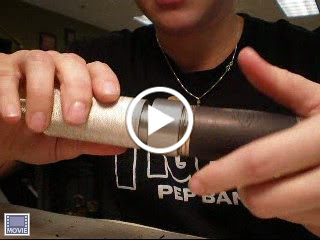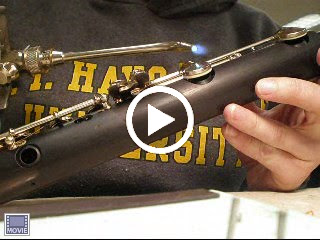 My project clarinet is a Leblanc 6-61 wood bodied clarinet. It is very dirty and has a cracked bell tenon. I'm excited to see how we will fix that. It appears that some of the hinge rods and pivot screws are stuck. It will get cleaned and fully repaded & corked.
My project clarinet is a Leblanc 6-61 wood bodied clarinet. It is very dirty and has a cracked bell tenon. I'm excited to see how we will fix that. It appears that some of the hinge rods and pivot screws are stuck. It will get cleaned and fully repaded & corked.
After disassembling, I had to remove one post because the screw is stripped and rusted in. Someone attempted to remove it before, but it doesn't look like they were successful. I washed the body with Murphy's oil soap, and I put the keys through the degreaser and the pickle. I cleaned and polished the hinge rods. Next I addressed a leak in the upper joint. I had to seal the clarinet, submerge it under water, and then use air pressure to find the leak. It was in the A/D finger ring tone hole. I used super glue to seal it.
When Lucas (Lucas Pemberton, my instructor) found the letters U.S.N. and 6-61(which I thought was the model number) stamped above the serial number of my clarinet. He thinks it stands for U.S. Navy and June '61. So I may be working on a clarinet that is almost 50 years old that spent some time in the Navy!!

The pivot screw did not come out even after soaking in penetrating oil for a week. I heated and quenched it, but that didn't make a difference either. We dissolved the screw by boiling it in alum and water for about seven hours. Alum attacks ferrous metals, so it dissolved the steel screw but not the nickel post.
 I also repaired a crack in the barrel of this clarinet. I had to take the ring off, split open the crack, and seal it with super glue. Then I filed away the excess glue, and did finishing work with sand paper and crocus cloth to make the crack nearly invisible. I refit the barrel by shimming with sand paper to make it press fit. After refitting the ring to the barrel, the barrel did not fit the upper joint. I had ream out the barrel to make it fit again.
I also repaired a crack in the barrel of this clarinet. I had to take the ring off, split open the crack, and seal it with super glue. Then I filed away the excess glue, and did finishing work with sand paper and crocus cloth to make the crack nearly invisible. I refit the barrel by shimming with sand paper to make it press fit. After refitting the ring to the barrel, the barrel did not fit the upper joint. I had ream out the barrel to make it fit again. After All of the body work was done, I had to fit and buff the keys. Then I padded and corked the instrument. There are two videos below. One shows reaming out the barrel, and the other shows padding.
(videos are coming, they aren't uploading right now)
It turned out nice, and it plays so well I want to keep it!!

Just a note: The cracked bell tenon will get totally replaced, but I am going to wait until next semester to do that. I need more lathe experience first.

Just a note: The cracked bell tenon will get totally replaced, but I am going to wait until next semester to do that. I need more lathe experience first.








